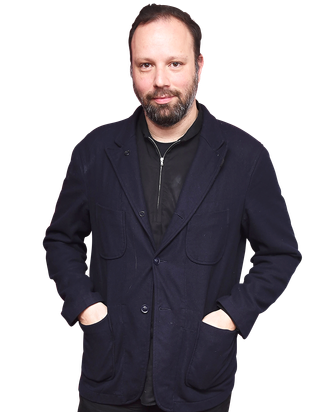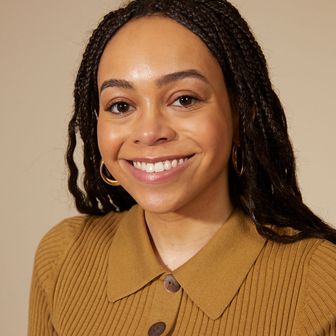
The Favourite is a puckish period drama: a disheveled queen keeps 17 bunnies caged in her bedroom, advisers stage duck races inside the palace, Emma Stone gives a hand job as she stays up late one night conspiring to poison her opponent. (We’re talking Blair Waldorf levels of backstabbing.) The Favourite is, in other words, fun. Instead of the routine, expansive dance scenes of other period pieces, The Favourite’s lords and ladies party in massive dining halls and vogue down 18th-century soul-train lines.
At the center is a trio of women that’s drawn comparisons to All About Eve. Queen Anne (Olivia Colman) is depressed but attention-seeking, the kind of ruler who takes business too personally. Sarah (Rachel Weisz) is the only person who can both soothe her and subdue her. Enter Sarah’s cousin Abigail (Stone), a penniless woman without a title, but who watches Sarah’s effect on Anne to see a window of opportunity. For money and a title, Abigail jockeys for Anne’s attention. “The fact that it was three women as protagonists with these complex characters was something that you rarely see anyway, and I was interested in exploring that,” director Yorgos Lanthimos said earlier this month in New York City. He never expected to make a period drama, but something about these women — their dynamics, their dynamism — felt right. “Also how we represent it visually: the theme of very intimate personal relationships and people affecting the fate of a whole country or the fate of the whole world.” He talked to Vulture about the movie’s secrets and schemes, and whether he’s good at keeping secrets himself.
I want to start with talking about the use of the fish-eye lenses. It’s a really striking visual image, seeing how lonely it makes these powerful people look in these massive bedrooms and gardens. Can you tell me how you arrived at that?
Many factors led me to it. One is my general personal preference: The last few years I’ve been experimenting a little bit with wide-angle lenses anyway. But on this film in particular it just felt more appropriate. It wasn’t necessary that I knew from the beginning that we’re going to use so extreme wide-angle lenses so much, but it was in my head.
As soon we started testing them, and then when we started filming, it just became apparent that it fit the space but also the feel of the film as well. From the beginning, I wanted to juxtapose those really big, empty spaces with close-ups of the people. In a way it reflects the part of the film that is about this intimate story about these three women and their personal relationships, but also how their relationships and their intimate story affects a much bigger world, and a much bigger frame. By showing these huge spaces even bigger and more distorted, and seeing everything within the space, and seeing how small the people can be in that space, it just felt that it represented a lot of themes in the film. Weirdly enough, although you see more of a space, it feels more claustrophobic. You see everything, but you’re actually seeing what they’re enclosed in.
Right, these three women are mired in this complicated relationship, but they’re trapped in these massive rooms. It has a really isolating effect.
Yeah, like they’re trapped in these big spaces but you see where it ends. It’s not infinite.
What did you make of the conflict — where two women are jockeying for the attention of a third — when you first read the script?
As soon as I read the story and the original script by Deborah Davis, I knew that this was an interesting story. The fact that it was three women as protagonists with these complex characters was something that you rarely see anyway, and I was interested in exploring that. But also, just what I said before, how we represent it visually: the theme of very intimate personal relationships and people affecting the fate of a whole country or the fate of the whole world.
Those themes were very interesting to me, and then I was intrigued in making a period film, which I’d never done before and see how I can tackle that. But I knew that I would have to find a very specific tone for this film in order to make it my own, to find the reason why I’m making a British period film about a queen in England in the 18th century.
Did you ever think you’d make a period film at all?
Many years ago? No. I never knew that I would even be making English-language films. I never knew that I would be making a period film, for sure. No. This one was surprising to me. But I think things take their own course. I don’t make long-term plans for sure.
So what was important to you to get right about these women? I like that the movie allows them to be sort of mysterious. It’s very vexing, in a good way.
It was important for me to find a writer that I would work with in order to find that tone and encapsulate it. It took a while to find that writer, Tony McNamara, and we worked for a long period of time intermittently in order to try and create these women as very complex and complicated. Sometimes they’re mysterious, sometimes not very sympathetic, sometimes the opposite. We were trying to create those complete human beings in a way that you wouldn’t be able to just characterize them in a second after you saw what they do, or how they look, or their behavior.
Of course, we had to take a lot of liberties with history or what we knew about it. You don’t really know that much or what went on — the basic stories, a few things about the people — but you don’t really know what happened behind closed doors, so you invent. But from the beginning we decided to go off and create and invent things that would make the story feel complete and would construct a story that allowed us to speak about the things that we wanted to speak about.
There’s so many shots in the movie of just Emma observing Rachel and observing Olivia, just watching. She’s so expressive with her eyes. What, for you, was important about those shots?
It was exactly that. I enjoy sometimes focusing on a character in a scene that’s not actually doing the main action, or the talking. I think you can tell a lot about people if you observe them as they’re observing. It was her character, storywise, was someone who was new in this world and she was trying to figure out how it worked and all of that. I think sometimes actors, when they don’t have a line or a certain action, and you’re focusing the camera on them for so long they try to do a lot of things. It can feels very self-conscious sometimes, and not real at all. It’s not how we observe people. We don’t know that we’re observing or understanding — some of us, or most of us, anyway. I think what was great about Emma is that she understands the subtlety that is necessary in order to not appear self-conscious. And you can tell a lot about her character without her having to do a lot.
Do you like to gossip?
Me, personally?
Yeah.
Not so much. Well, like any normal person would. But, no. It’s not a main thing that I do.
Are you good at keeping secrets?
I think I am, yeah. [Grins.] I might only tell to a very close person something about someone, but I kind of take it seriously when something needs to be kept a secret.
In contrast to all of these scenes of scheming and plotting, there’s the great scene of Joe and Emma roughhousing in the forest. What was it like shooting that?
I really enjoyed that scene. It’s a bit of an homage, for me, to a Greek filmmaker and this Greek film called Evdokia. It has an amazing film with a couple beating each other on a beach.
I was surprised by how much Joe and Emma were into it and really went for it. They were diving around and tackling each other. It was really exhilarating to watch that, and kind of dangerous at the same time. You felt a certain kind of tension with that thing going on in front of you. So, that was something that has stayed in my mind.
How many dresses did Emma go through in that scene?
Not many because we didn’t have money for many. It was just the one, I think, and then we had to have another one that was a proper one.
That’s so funny.
We would clean the dress up as soon as they got up. We couldn’t do so many takes as well, ’cause we didn’t want them to be jumping around in the forest for so long. So, we did very few takes and then we would clean them up afterwards.
This is truly a movie with three leads, but the machinery of awards season requires one person to be submitted for that lead category. Is it hard for you, as the director, to think about the story and these performances in that way? I’d imagine it’d be hard to push characters so complex into categories.
It just felt really weird that we had to do that. And I guess for practical reasons you kind of have to. But to me, from day one when we started writing the script, I felt that this was gonna be a film about these three women and they were going to be equal, and in different times within the film each different one would rise up above the others or take the lead. I wanted it to change throughout the film, and I think that’s how we did it.
Directing the film, I felt that there wasn’t one particular perspective from one character but, again, it will alternate between the three women how you view this story. It will be through all three of their viewpoints. I don’t know how you [make the category choice]. It’s really hard. But I guess for practical reasons we have to do it, and it involves how the actors feel as well. But I just would love to not have to make that choice.
This is just a practical question: How many ducks were there, and how many rabbits?
I don’t know. I mean, the rabbits were 17 for sure. We had a couple of others, but it was because the queen had lost 17 children so they represented all the children she lost. I’m not sure about the ducks, how many there were.
Who came up with having this very important politician walk his champion duck on a leash?
At some point it was cockfighting, but we couldn’t do cockfighting. In the beginning he was walking around with a rooster. It was just an interesting idea for a pet that someone might have at that time. We were kind of flirting with all those ideas that felt out of place in a palace. But at the same time, when we were looking into it, we were seeing drawings of paintings of actually cockfighting happening. So why wouldn’t someone also be walking a rooster around?
This interview has been edited and condensed for clarity.


